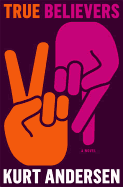
As Kurt Andersen's rambunctious True Believers opens, narrator Karen Hollander turns down a potential Supreme Court nomination, knowing the political vetting process will expose a secret she has been carrying since her radical student days in 1968. Instead, she begins a memoir to tell the true story of those years. Jumping back and forth in time, the novel gradually uncovers what really happened when she was 18 and hellbent on saving the world.
Andersen brings all the wit he honed at the Harvard Lampoon and Spy, as well as the probing eye for cultural details shown in his previous novels, Turn of the Century and Heyday. In Karen's granddaughter Waverly, an Occupy protester, he brings to life the contemporary fruit of the seeds planted in the protests of the Vietnam era.
Beneath the surface of Karen's memoir runs an early abandoned Catholicism with the repetitive superficiality of its confession/absolution pattern--"rinse, repeat, rinse, repeat," as her latest lover calls it. Likewise, her childhood infatuation with Ian Fleming's James Bond novels and their romantic duels between good and evil haunts her.
In Andersen's epic novel, the young always think that they are on to something new, that their drive to change the world justifies their behaviors, that the improved future will forgive them. It is the great ambiguity of the 1960s that the grandchildren of the baby boomers discover that the practicalities of career and family often force us "to work hard, become successful, and leave both radicalism and true love--every form of wild romance--to others." Only in the end does Andersen suggest that perhaps, after all her searching for the truth, Karen Hollander can break the cycle and rediscover some of the romance of her youth. --Bruce Jacobs, founding partner, Watermark Books & Cafe, Wichita, Kan.

